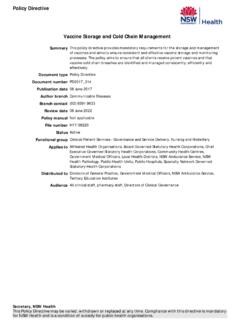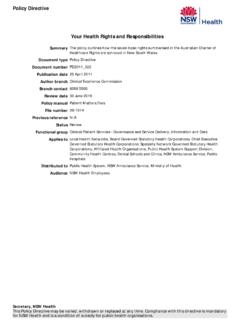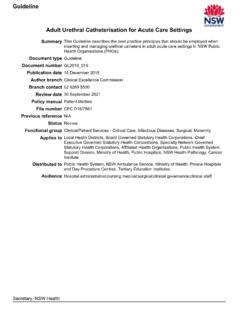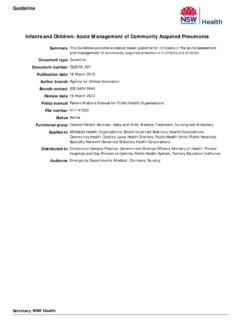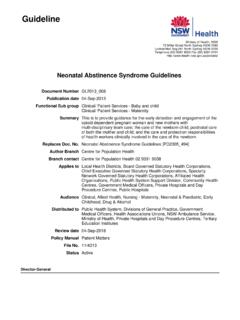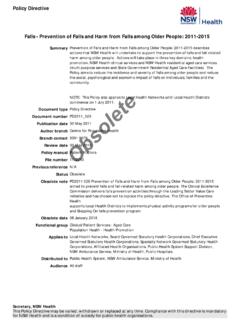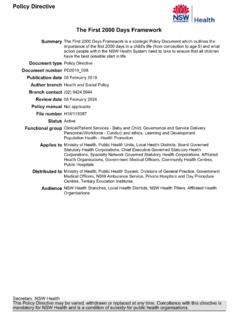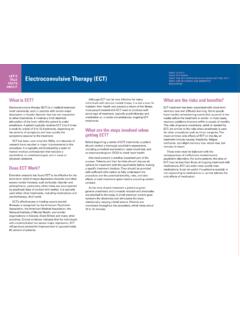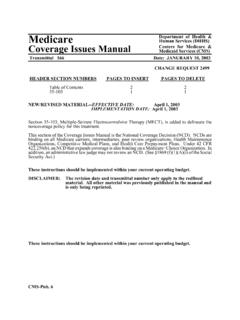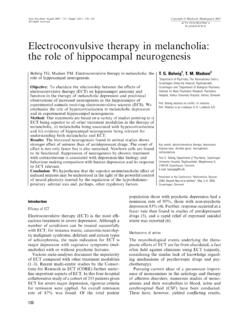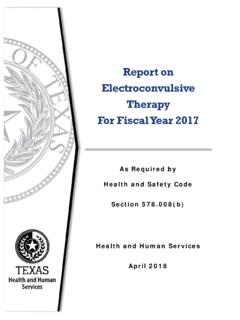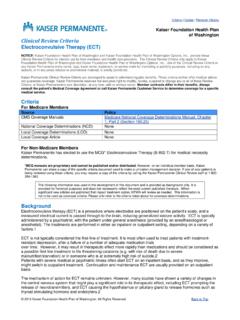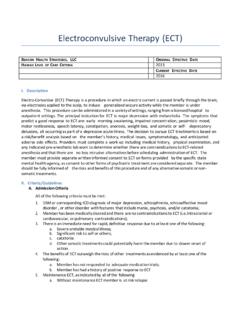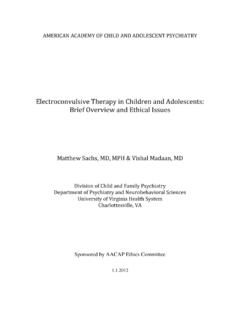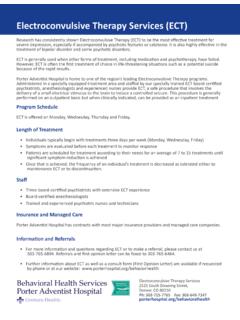Transcription of Electroconvulsive Therapy: ECT Minimum Standard of ...
1 Electroconvulsive therapy : ECT Minimum Standard of Practice in NSWS ummaryThis Policy defines Minimum standards for the use of Electroconvulsive therapy (ECT)in New South Wales. The standards apply to all facets of care, including the indications for treatment, potential risks and strategies to minimise them, issues of consent, facilities, anaesthesia, application of the procedure, and the required quality improvement framework.**Amended 8/11/13: Please note that Section , of Attachment 1 contained incorrect advice in relation to consent to ECT for people under 18 years of age. Refer to Section of Attachment 2: Guidelines.
2 ECT Minimum Standards of Practice in NSW for the correct typePolicy DirectiveDocument numberPD2011_003 Publication date18 January 2011 Author branchMental HealthBranch contact9424 5869 Review date30 June 2021 Policy manualPatient MattersFile numberPrevious referenceN/AStatusReviewFunctional groupClinical/Patient Services - Mental Health, Anaesthetics, Nursing and Midwifery, Governance and Service DeliveryApplies toLocal Health Networks, Board Governed Statutory Health Corporations, Chief Executive Governed Statutory Health Corporations, Specialty Network Governed Statutory Health Corporations, Affiliated Health Organisations, Public Health System Support Division, Community Health Centres, Public HospitalsDistributed toPublic Health System, Divisions of General Practice, Health Associations Unions, Ministry of Health, Private Hospitals and Day Procedure Centres, Tertiary Education InstitutesAudienceClinical;nursing;menta l health;emergency departmentsPolicy DirectiveSecretary, NSW HealthThis Policy Directive may be varied, withdrawn or replaced at any time.
3 Compliance with this directive is mandatory for NSW Health and is a condition of subsidy for public health organisations. POLICY STATEMENT PD2011_003 Issue date: January 2011 Page 1 of 2 Electroconvulsive therapy (ECT) PURPOSE This Policy Statement defines Minimum requirements that must be met in the delivery of Electroconvulsive therapy (ECT) in New South Wales. These requirements apply to all facets of care, including the indications for treatment, potential risks and strategies to minimise them, issues of consent, facilities, anaesthesia, application of the procedure, and the required quality improvement framework.
4 MANDATORY REQUIREMENTS The Minimum requirements that must be met by health care providers and the health care system are detailed in Attachment 1. This policy statement is to be read in conjunction with the Guidelines: ECT Minimum Standards of Practice in NSW (Attachment 2). IMPLEMENTATION Roles and responsibilities of the NSW Department of Health: Provide advice and assistance for the implementation of this policy. Monitor and evaluates the health system implementation of standards for ECT. Roles and responsibilities of Chief Executives: Assign responsibility, personnel and resources to implement the standards for ECT.
5 Report on the implementation and evaluation of ECT standards to the NSW Department of Health. Roles and responsibilities of the health service executives responsible for clinical operations and governance: Ensure successful implementation of the ECT standards. Monitor and evaluate the implementation of ECT standards across their services and feedback evaluation results to staff. Ensure the ECT standards are incorporated into orientation programs for relevant clinical staff. Educate relevant clinical staff in the use of the ECT standards. Roles and responsibilities of hospital, facility, clinical stream, unit managers and heads of departments: Locally implement the ECT standards.
6 Evaluate compliance with the ECT standards. Annually monitor and evaluate local ECT practices and processes in line with the ECT standards. Roles and responsibilities of all clinicians: Ensure their work practices are consistent with the Standard for ECT. POLICY STATEMENT PD2011_003 Issue date: January 2011 Page 2 of 2 REVISION HISTORY Version Approved by Amendment notes January 2011 (PD2011_003) Deputy Director-General Strategic Development Rescinds PD2010_068. Incorporates the Minimum requirements in the delivery of ECT in NSW November 2010 (PD2010_068) Deputy Director-General Strategic Development New policy ATTACHMENTS 1.
7 Minimum Requirements in the delivery of ECT in NSW 2. Guidelines: ECT Minimum Standards of Practice in therapy : ECT Minimum Standards of Practice in NSW Attachment 1 PD2011_003 Issue date: January 2011 Page 1 of 3 Electroconvulsive therapy (ECT) The following are in the Minimum requirements that must be met in the delivery of Electroconvulsive therapy (ECT) in New South Wales. 1. Indications for Electroconvulsive therapy The indication for the use of ECT must be clearly documented in the patient s file, including both the diagnosis and the reason for the choice of ECT. A second opinion from a psychiatrist experienced in the practice of ECT should be sought: when there is any uncertainty about the recommendation of ECT, when ECT is being considered for treatment of indications other than those listed at - of the Guidelines: ECT Minimum Standards of Practice in NSW.
8 2. Risks of ECT There are no absolute contraindications to ECT. The clinician must conduct a case-by-case risk benefit analysis, and take appropriate action to manage the risks of ECT. All patients receiving ECT must undergo assessment of cognitive function prior to ECT, during the ECT course, and at the completion of the course. Unusual levels of confusion or memory problems detected during the course must prompt a review of ECT prescription and technique. 3. Consent and legal issues The administration of, and consent for, ECT must comply with the provisions of the NSW Mental Health Act 2007. 4. ECT facilities All ECT facilities must comply with the relevant standards specified by professional bodies and NSW Health.
9 5. Preparing the patient for ECT A pre-ECT work-up must be performed and documented, including a thorough history, physical examination, clinically relevant investigations and specialist consultations. An anaesthetic consultation is mandatory. Medical and psychotropic medications must be reviewed and adjusted as appropriate before commencing a course of ECT. A check list of pre-ECT procedures must be completed before each treatment. 6. Administration of ECT The choice of ECT electrode placement, stimulation parameters and electrical dosage for each patient must be based on considerations of efficacy and cognitive outcomes, and should be in accordance with accepted guidelines.
10 The ECT machine must have EEG monitoring capacity, be maintained in good working order and serviced at least once every 12 months. Electroconvulsive therapy : ECT Minimum Standards of Practice in NSW Attachment 1 PD2011_003 Issue date: January 2011 Page 2 of 3 Sine-wave ECT should not be used. EEG monitoring should be routinely performed, and EEG strips filed chronologically so that they can be easily accessed to review the treatment course and guide decisions about dosing. The NSW Health policy Correct patient, correct procedure, correct site (PD2007_079) must be observed during the ECT procedure.

